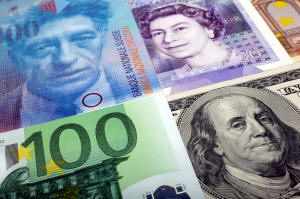|
Investors' appetite for riskier assets has been hurt so far this
year by expectations that the Federal Reserve will begin
tightening monetary policy, starting with a rate hike at its
March meeting.
Strong earnings helped global stocks rise on Wednesday, but they
struggled to maintain this momentum during the Asian and early
European sessions on Thursday.
Sweden's central bank took a dovish stance, keeping its monetary
policy plans broadly unchanged and stressing its view that
surging inflation is temporary.
The Swedish crown fell. The U.S. dollar was up 0.9% against the
krona at 1158 GMT, a one-week high.
The euro was also up 0.9% against the krona, at 10.509, a 10-day
high.
"Even the ECB has now moved to take a more serious stance on
inflation," said Ima Sammani, FX market analyst at Monex Europe.
"So the fact that the Riksbank didn’t join them in this view…
leaves the krona quite vulnerable to higher inflation
expectations," she said, adding that the move lower in the
Swedish crown "could very well continue."
Sammani said that policy divergence between Norway - which is
more hawkish - and Sweden would drive the NOK/SEK pair higher.
Last week, the European Central Bank surprised investors by
appearing more concerned about inflation and more willing to
tighten monetary policy, prompting euro-dollar to jump to a
three-week high of $1.1483.
At 1202 on Thursday, the euro-dollar was up 0.1% on the day at
$1.1432.
The dollar index was little changed at 95.543. After large
swings in the previous two weeks, it was on track for a minimal
weekly change so far this week.
The Japanese yen hit a one-month low versus the dollar. The
currency showed little reaction to the Bank of Japan saying that
it would intervene in markets by offering to buy an unlimited
amount of 10-year Japanese government bonds at 0.25%.
Markets were focused on U.S. inflation data due later in the
session. The headline consumer price index is expected to have
increased more than 7% in January, year-on-year, a level
reminiscent of the inflation shocks of the 1970s and 1980s.
"The higher the current inflation rates the stronger the
perception is likely to be amongst market participants that the
Fed will have to act even faster, more decisively and for a
prolonged period of time than is currently expected," wrote
Commerzbank FX and EM analyst Antje Praefcke in a client note.
"That in turn is likely to provide a boost for the dollar."
Investors are pricing in a 70.5% chance of the Fed hiking rates
by 25 basis points at its March meeting, with a 29.5% chance of
a 50 bps raise. [IR/PR].
The Australian dollar, which is seen as a liquid proxy for risk
appetite, was up 0.3% at $0.72025, while the New Zealand dollar
was also a touch higher.
In cryptocurrencies, bitcoin was around $44,916, in its third
consecutive week of gains. But it remains far below the all-time
high of $69,000 it hit last November.
(Reporting by Elizabeth HowcroftEditing by Bernadette Baum)
[© 2022 Thomson Reuters. All rights
reserved.]
This material may not be published,
broadcast, rewritten or redistributed.
Thompson Reuters is solely responsible for this content.

|
|





